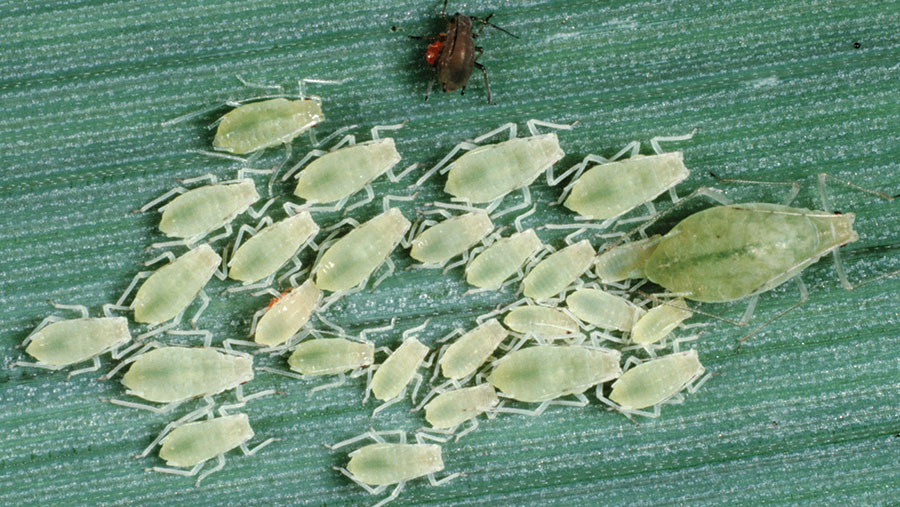Aphid migration could be more than a month earlier this year
 © Nigel Cattlin/Science Photo Library
© Nigel Cattlin/Science Photo Library Aphid migration could be more than a month earlier in some regions this season due to the relatively mild winter, which allowed the pests to over-winter in crops.
Monitoring of cereal crops is therefore essential for the rapid identification of aphid flights and effective disease control, with late-sown crops being particularly vulnerable to attack.
Steve Ellis, entomologist at crop consultants Adas, says no reports of aphids have currently been identified in winter-sown cereals, but growers should be vigilant.
See also: Alerts a vital tool in pest and disease control this spring
“Aphid population numbers are starting from a low level, so growers should monitor crops closely to see if thresholds are reached,” says Dr Ellis.
Aphid flight
Mild weather conditions saw temperatures in January and February rise above the 30-year average, meaning aphid flights in southern counties of England are expected to be a month earlier.
The suction-trap network, which is run by Rothamsted Research, has a series of weather and insect data collection sites spread across the UK.
Sites in Kirton, Lincolnshire, witnessed a 2C rise in temperature, while further south in Silwood, Berkshire, temperatures increased by 2.5C.
In the absence of abnormal weather conditions this spring, aphids are expected to fly about four weeks earlier across the majority of England from The Wash southwards and potentially five weeks earlier than average in the Silwood area.
Further north in Scotland and northern England, aphids are predicted to fly about one to three weeks earlier, due to temperatures rising by 1.5C.
“There is concern that the mild winter will cause aphid populations to rise rapidly in the summer months as a result of their earlier migration,” says Dr Ellis.
However, he adds that this winter was the fifth wettest on record in the UK, with several Atlantic storms creating deluges across the country, which may restrict aphid migration and suppress population growth.
BYDV
Dr Ellis warns growers that barley yellow dwarf virus (BYDV) is the biggest threat to cereal crops from aphid attack, with yield losses of up to 25%.
He advises growers to ensure optimum crop nutrition to enable plants to rapidly reach growth stage 31, which is the onset of stem elongation, as greater plant maturity makes crops more tolerant to pest attack.
“Many crops are now approaching growth stage 30 so are less vulnerable to damage by aphids, but later-sown crops that are under-developed will be more at risk,” he adds.
Dr Ellis also highlights that the disease is more difficult to control in spring-sown crops than winter-sown ones because migration doesn’t end during the spring and early summer months, so particular care should be taken to monitor these crops.
Sprays and thresholds
An insecticide spray should only be applied once the threshold is reached to avoid resistance build-up.
“Before growth stage 61, the threshold is reached when 50% of tillers are infested, while beyond growth stage 61, until two weeks before the end of grain filling, the threshold is reached when two-thirds of ears are infected,” says Dr Ellis.
A full rate of pyrethroid is still an effective control method if used at the correct timing as resistance has only been detected in the grain aphid but not in the bird cherry-oat aphid.
Predicted date of first catch of cereal aphids in selected Rothamsted insect survey suction traps |
|||
|
Site |
Bird cherry-oat aphid |
Grain aphid |
Rose grain aphid |
|
Dundee |
25 April – 7 June |
7 May – 14 June |
29 April – 16 June |
|
Newcastle |
17 April – 30 May |
27 April – 30 May |
26 April – 4 June |
|
Hereford |
10 February – 21 May |
2 April – 7 May |
11 April – 26 May |
|
Rothamsted |
25 March – 1 May |
31 March – 4 May |
29 March – 12 May |
|
Starcross |
3 January – 3 April |
2 March – 28 April |
25 January – 14 April |

